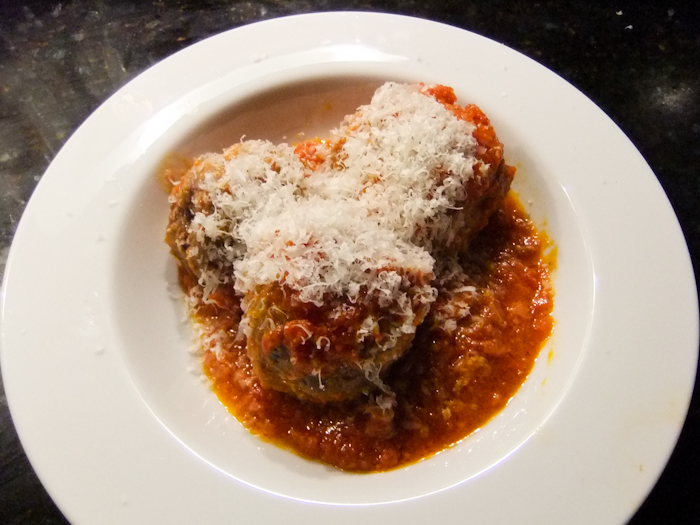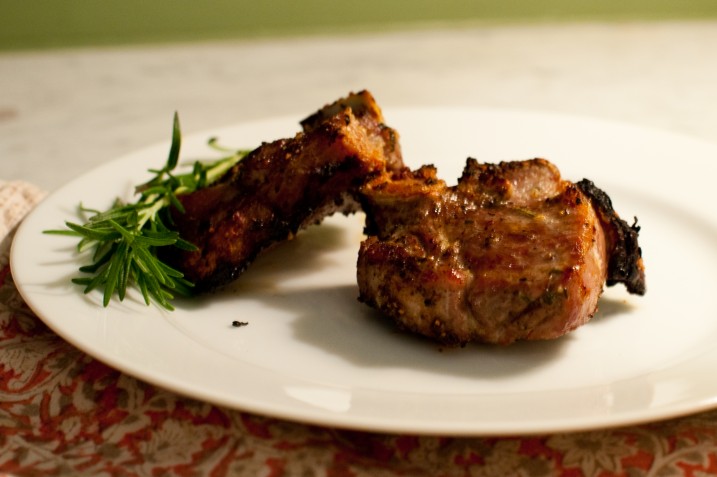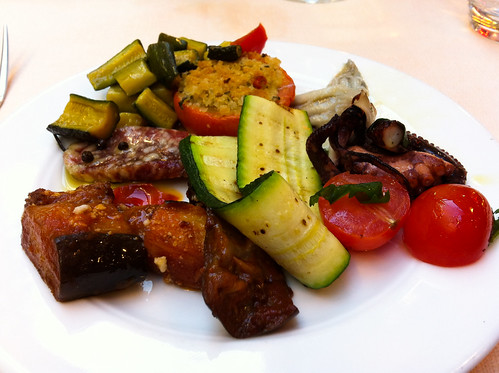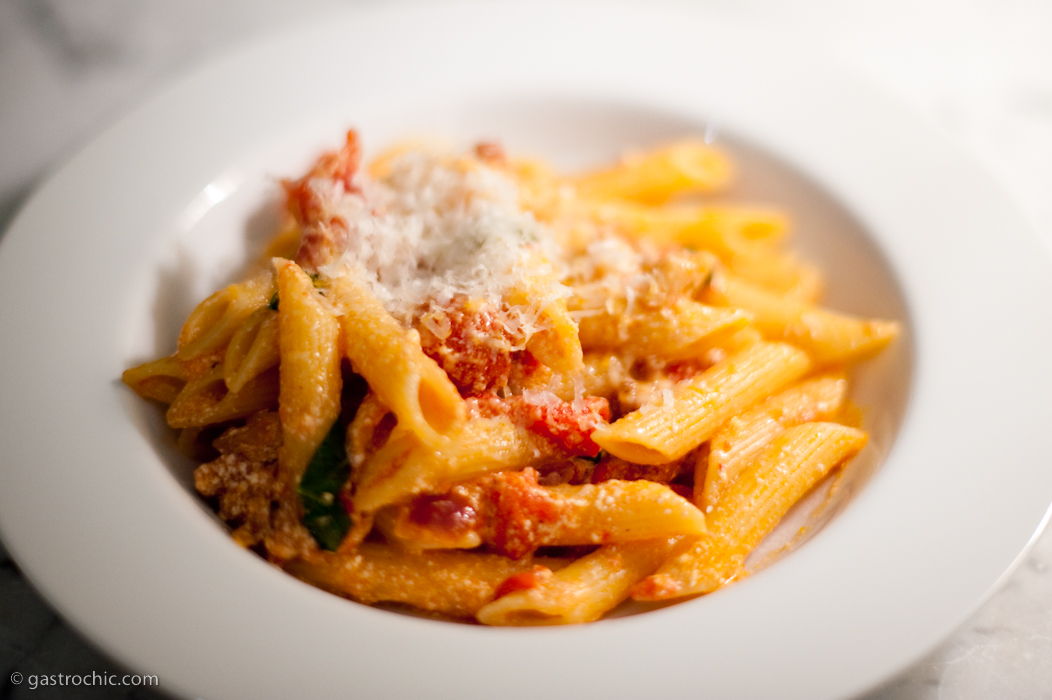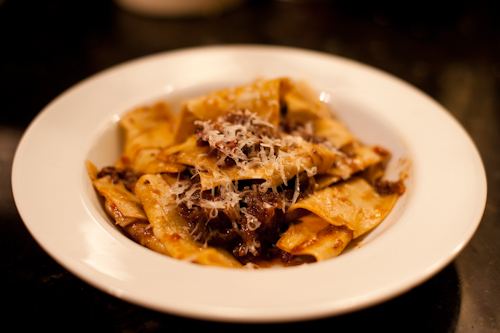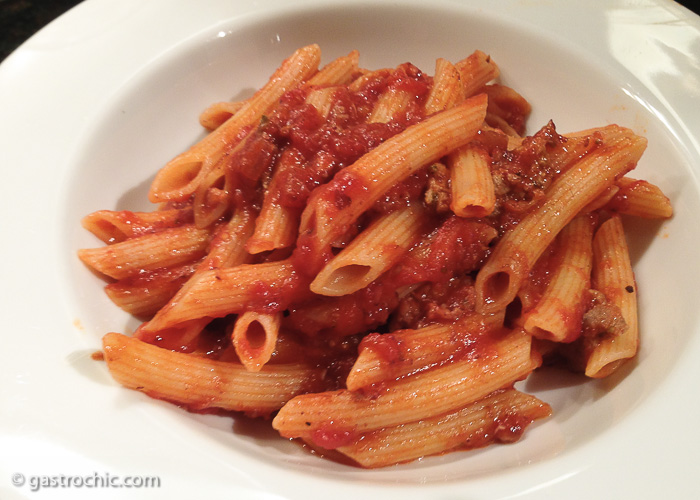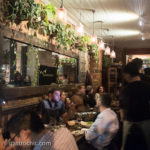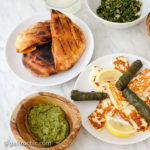Tag Archives: Italian recipes
Recipe: Pasta with Prosciutto and Peas
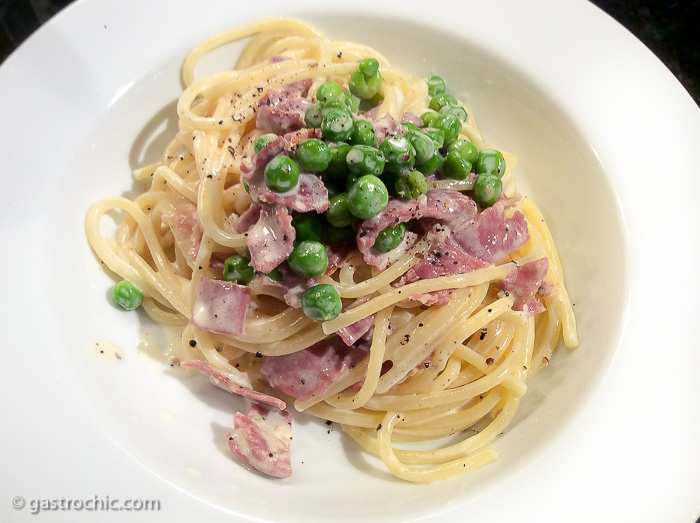
You know you’re old when you’ve been making a recipe for literally 20 years, but that’s when this recipe dates from – the ’90s heyday of the Silver Palate cookbooks. It’s so simple, so fast and so good, and I always return to it in spring. As with all Italian recipes, the quality of the ingredients is key. It’s important to get the best quality prosciutto you can find, prosciutto di Parma or prosciutto San Daniele. Same with the cream, butter and pasta. The original recipe calls for capellini (or “angel hair pasta” in ’90s speak), but I found that pasta to be too fine for the rich sauce, so I use spaghetti. Other variations from the original Silver Palate recipe: I leave out the flour, which can make the sauce gummy, and sneak in a smashed garlic clove for extra depth. (more…)
Recipe: New Old-School Meatballs
Recently I’ve been fascinated by the Meatball Shop. I’ve never actually eaten there, because there’s always a line out the door, and every time the owners open a new branch, an additional line forms out of an additional door, with no impact on still crowded original Meatball Shop. And they don’t take reservations, which to me is not a comforting quality for a comfort food place. Still. The place is insanely popular. (more…)
The Copycat Chef: Garlic and Rosemary Lamb Chops
In springtime I always start craving lamb with garlic and rosemary. But if you don’t have eight or more people to feed and several hours to spare, there’s not much reason to roast a whole leg of lamb. The solution: lamb chops for two, marinated and grilled for a short amount of time with the same intense flavor. This recipe is just as good for a casual weeknight meal as it is for a special occasion like Easter.
The Copycat Chef: Roasted Vegetable Antipasto
One of the best things about many Milanese restaurants is the antipasti bar. You pay one fixed, economical price for a buffet plate full of vegetables, olives, calamari, salumi and cheeses, rather than order antipasti item by item as in New York. It’s a much cheaper and easier way to get a mealtime supply of veggies.
When I came back to the U.S., I couldn’t find a recipe that replicated the roasted zucchini in the delicious antipasti plate at Primafila, a little pizza place on a side street off the Duomo, pictured above. This recipe for a mix of roasted vegetables came close, but here’s a revised recipe, simplified further, which can be served as an antipasto or as a contorno. All fresh vegetables need is a little olive oil, lemon, pepper and salt to become the perfect side dish.
The Copycat Chef: Penne with Ricotta and Pancetta
Down the street from me in Milan was a little neighborhood trattoria, La Ragazza, that served the most delicious pasta. The rich pancetta and tomato sauce in their signature penne dish included lots of creamy, fresh ricotta – a combination you don’t see often stateside. The only problem was, when I returned from Milan, La Ragazza was no longer down the street from me, and I was still craving their house specialty. So I set to Googling, and found the traditional recipe from an Italian pasta blog, Pasta Recipes Made Easy. Success! Here it is re-envisioned with American measurements and a few pasta-making tricks of my own.
La Ragazza’s penne is housemade and dried. If you can’t find this at a specialty pastaria near you (there are many more in Italy than here), use artisanal-quality packaged pasta. (more…)
The Babbo Cookbook: Oxtail Ragu
I must have bought The Babbo Cookbook as soon as it came out nine years ago, but it included so many recipes that were nearly impossible to make until now. Remember when guanciale wasn’t exactly a household word? Oft-mentioned ingredients like boar sausage, beef cheeks and calf’s brains may still not be available at your local Gristede’s, but now Eataly’s butcher counter sells oxtail meat. (more…)
Caprese Salad
What’s so difficult about making caprese salad? On the other hand, if it’s so easy, why do so many restaurants not deliver? This summer salad of tomato, basil and mozzarella is quintessential Italian cuisine: excellent ingredients simply presented. But it takes technique to get the flavors to blend just so on the plate – otherwise it’s just mozzarella and tomato that happen to be in the same vicinity.

We experimented with several methods to arrive at one luscious whole. As expected, it depends a lot on sourcing top notch tomatoes in season, but there are a few more tricks that can elevate the dish from good to great. (more…)
Ribollita
Ribollita, which translates literally as “reboiled,” is a traditional Tuscan white bean soup that’s on nearly every menu in Florence during the colder months. Ask for it during late spring or summer, however, and they’ll laugh: Fall, when leafy green vegetables are at their peak, is the best time to make this hearty vegetable soup. The most important ingredient in this vegan dish is the slightly bitter cavolo nero or Swiss chard, which gives ribollita its distinctive taste. It takes three days to make ribollita properly, but it’s worth it!
The recipe, after the jump. (more…)
Accidental Plum Pizza
A fig tart with Stilton and caramelized onions looked so good on the cover of last Wednesday’s NYT Dining section that I offered to make it for a friend on Saturday night. A snack of pastry sprinkled with figs, blue cheese and pine nuts seemed like the perfect fuel for a night on the town. The only problem?
Everyone else in New York had the same freakin’ idea.
You know the feeling: you get to Trader Joe’s or Whole Foods only to find a gaping hole on the shelf where a main ingredient should be. There had been a run on frozen puff pastry at Whole Foods, and the cheese department was sold out of Stilton.
Since I had already bought all the other ingredients and had no more ideas at 7pm on a Saturday, I swapped out frozen pizza dough ($1.69) for puff pastry and, at the cheese counter guy’s suggestion, Jasper Hill Bayley Hazen Blue for Stilton. Problem solved! Or so I thought. (more…)
Pasta with Wild Mushroom Sauce
There are so many different varieties of mushrooms arriving at the market right now, like these at Dean & Deluca, below, that it’s hard to choose just one. How can you settle for just cremini when chanterelles, oyster mushrooms, and hen o woods are right nearby? Usually the answer comes down to price: the fanciest mushrooms can cost $45 a pound, so many cooks stick to the basics. But keep in mind that just an ounce of mushrooms can go a long way flavor-wise, so cooking with exotic mushrooms can be done with little pain to your wallet. Just use a higher proportion of less-expensive mushrooms (cremini) and a smaller proportion of the pricier ones (chanterelles).
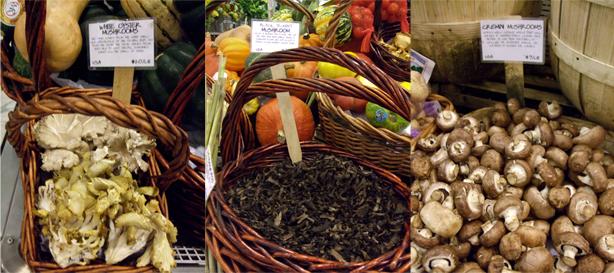
One of the best recipes that uses wild mushrooms is one by Melissa Clark for the Times in the spring of 2007, for creamed morels on toast. But what about fall, when morels aren’t in season? All the mushrooms I found at Dean & Deluca would be excellent with cream and white wine on toast, but I wanted to feature them in a main dish. The creamed mushrooms became an unorthodox French pasta sauce served on linguine – though for a really stellar effect, serve the mushroom sauce over fresh, homemade fettuccine. (more…)
The Copycat Chef: Raw Tomato Soup With Garlic Croutons
This recipe is based on Nigella Lawson’s Spaghetti al Sugo Crudo from her excellent summer house cookbook, Forever Summer. Spaghetti made with fresh uncooked tomatoes and garlic is delicious when tomatoes are in season—though the sauce gets watery if you let the tomatoes sit too long. This never stopped me from slurping up the leftovers with a spoon, however, so I thought: why not make the whole thing a soup?
The result is pretty insane, like intense Sicilian sunshine in a bowl. The ingredients may be rustic, but the finished product looks and tastes quite sophisticated. (Serve it in smaller portions as an amuse bouche.) The soup can be frozen for the winter months, when you’re really craving that dose of sunshine. (more…)
The Copycat Chef: Fried Polenta (Scagluzzoli)
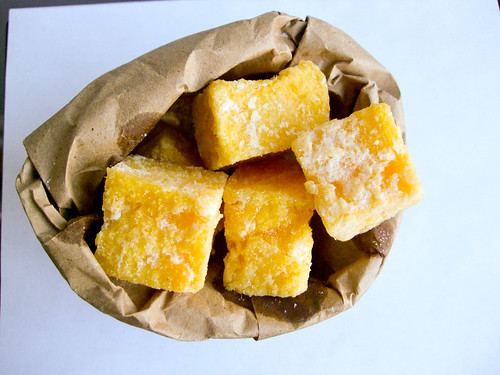 It’s thrilling to find that the addictive Italian street snack scagluzzoli, or fried polenta, is finally hitting restaurants in New York. The Standard Grill, Tonda, and several other places now have fried polenta on the menu, but unfortunately, New York versions are often too fancified to be considered a snack of the people. Unlike the plain fried polenta in Florence, here it’s often cut into fancy wedges or gussied up with extraneous ingredients like basil and artisanal cheese. This is bad enough, but to fry polenta so that it’s limp, not crispy? Utter blasphemy. (more…)
It’s thrilling to find that the addictive Italian street snack scagluzzoli, or fried polenta, is finally hitting restaurants in New York. The Standard Grill, Tonda, and several other places now have fried polenta on the menu, but unfortunately, New York versions are often too fancified to be considered a snack of the people. Unlike the plain fried polenta in Florence, here it’s often cut into fancy wedges or gussied up with extraneous ingredients like basil and artisanal cheese. This is bad enough, but to fry polenta so that it’s limp, not crispy? Utter blasphemy. (more…)
German Jazz Guitarist Pasta
 Reading Mark Bittman’s article about pasta in the Times today, I couldn’t help but be reminded of a German jazz guitarist I knew years ago. This was no ordinary German jazz guitarist, but a half Italian German jazz guitarist and who made a mean penne arrabiata chock full of vegetables. He and his cousin Fabio, also a jazz guitarist, lived in Dumbo in an old gun factory that had been (illegally) converted into loft apartments.
Reading Mark Bittman’s article about pasta in the Times today, I couldn’t help but be reminded of a German jazz guitarist I knew years ago. This was no ordinary German jazz guitarist, but a half Italian German jazz guitarist and who made a mean penne arrabiata chock full of vegetables. He and his cousin Fabio, also a jazz guitarist, lived in Dumbo in an old gun factory that had been (illegally) converted into loft apartments.
 Pasta was one of their favorite things to make, particularly since the gun factory was only heated from 9-5 on weekdays, and eating hot pasta was one way to stay warm. It was the German jazz guitarist who taught me that you must put an entire handful of salt into the pasta water. He also insisted on Pomi tomatoes, since they contain none of citric acid that can make canned tomatoes sour. Like the recent immigrants mentioned in Bittman’s article, they too were overjoyed by the bounty of food available in America. They bought lots of cheap vegetables at the local Korean deli and shoplifted the expensive Parmesan.
Pasta was one of their favorite things to make, particularly since the gun factory was only heated from 9-5 on weekdays, and eating hot pasta was one way to stay warm. It was the German jazz guitarist who taught me that you must put an entire handful of salt into the pasta water. He also insisted on Pomi tomatoes, since they contain none of citric acid that can make canned tomatoes sour. Like the recent immigrants mentioned in Bittman’s article, they too were overjoyed by the bounty of food available in America. They bought lots of cheap vegetables at the local Korean deli and shoplifted the expensive Parmesan.
The resulting pasta dish was just as filling as it was nutritious. And the cheese on top? For us, it was worth the risk.
German Jazz Guitarist Pasta
 1 clove garlic
1 clove garlic
1 zucchini
½ yellow onion
5 oz. white mushrooms
2 tbsp extra-virgin olive oil
2 cups Pomi chopped tomatoes
1 tbsp tomato paste (look for the kind in the tube)
1 tsp drained capers
Oregano
Red pepper flakes
Salt to taste
1/4 lb. penne
Parmesan cheese
Put a handful of kosher salt in an 8-quart pot of water and bring it to boil.
While waiting for water to boil, mince the garlic. Cut zucchini on a diagonal. Slice onion in wedges lengthwise. Slice mushrooms. Heat oil over medium-high heat until it begins to shimmer. Add garlic, stir a few times, then add the rest of the vegetables. Saute, stirring constantly, until the zucchini just begins to get transparent in the center. Add tomatoes, tomato paste, capers, two dashes of oregano, one dash of red pepper flakes. Heat on high until it bubbles, then keep on a low simmer, uncovered. By now the pasta water should be boiling; add penne and cook.
Reserve some of the pasta cooking water. Drain penne while still al dente. Check the sauce’s seasonings and salt to taste. Add some of the reserved pasta cooking water if sauce is too thick. Finish cooking the penne in the sauce. Raise the heat and stir constantly until some of the sauce is absorbed.
Serve topped with a generous amount of freshly grated, legally acquired Parmesan.
Serves 2 jazz guitarists.
Sunday Ragu
Every winter I like to make a huge vat of meat sauce and freeze it in small portions for the bleak months ahead. Though I am not copying any particular restaurant version here, the recipe is derived from Regina Schrambling’s nearly perfect recipe for lasagna that appeared in the Times years ago. The lasagna was great, but I was floored by the sauce. I tweaked it to make it more Italian-American than authentic Italian – more tomato, more oregano, less meat. Even a dash of garlic salt at the end, though yes, I know that is cheating. (more…)
The Copycat Chef: Risotto with Mushroom Fricassée from Café Gray
Why cook? There isn’t much need to in this town, home of 18,696 restaurants, many of which offer delivery to your door. It’s instant gratification, it’s indulgent, and best of all, it’s often cheaper than buying the ingredients and slaving over a hot stove yourself.
Cooking is an activity that many consider quaint and vaguely self-sacrificing. But I assure you it is nothing of the kind. I cook because I am even more of a diva than those who rely solely on delivery. I can’t stand pasta that isn’t al dente. I won’t eat Thai sauces that taste more like sugar than spice. And always, I want what I want when I want it, whether or not it is in my neighborhood and available for delivery. Thus, I learned to cook.
The Copycat Chef is a series that I will run at least once a month. In it, I attempt to recreate at home a particularly delicious dish I’ve had at a restaurant. It’s kind of a game, and here are the rules:
1. The chef’s recipe should be a secret one, not published in any of his or her cookbooks.
2. No one will tell me exactly what is in it.
3. It should be a signature recipe, very good, something you would crave when you think of that particular restaurant.
The mushroom risotto at Café Gray was an easy pick for this series. It is so good it made another reviewer actually lick her bowl, and it might even be the answer to somebody’s if-you-could-only-eat-one-thing-for-the rest-of-your-life question.
I studied several things at Café Gray to come up with the recipe:
 The Menu. The menu does not give away much; it says only “Risotto with Mushroom Fricassée.” But the word “fricassée” is a good clue. As Julia Child explains in Mastering the Art of French Cooking, “The fricassée is halfway between [a saute and a stew]. When chicken is fricasséed, the meat is always cooked first in butter–or butter and oil–until its flesh has swelled and stiffened, then the liquid is added.” So Gray Kunz has playfully adapted this technique to mushrooms.
The Menu. The menu does not give away much; it says only “Risotto with Mushroom Fricassée.” But the word “fricassée” is a good clue. As Julia Child explains in Mastering the Art of French Cooking, “The fricassée is halfway between [a saute and a stew]. When chicken is fricasséed, the meat is always cooked first in butter–or butter and oil–until its flesh has swelled and stiffened, then the liquid is added.” So Gray Kunz has playfully adapted this technique to mushrooms.
 Taste. The risotto was of excellent quality, obviously made with lots of butter, but cut by a hint of something tart – lemon? There were some interesting herbs mixed in. The mushroom sauce was harder to pin down. What gave it that level of complexity and darkness of color? It reminded me of an ingredient more prevalent in Chinese cuisine: the liquid that dry mushrooms sit in when they are reconstituted, liquid which is often added to the main dish in cooking. I came back to the cafe again for a second tasting. Something about the mushroom sauce reminded me of French onion soup. Then it struck me: onion! And a dash of cognac.
Taste. The risotto was of excellent quality, obviously made with lots of butter, but cut by a hint of something tart – lemon? There were some interesting herbs mixed in. The mushroom sauce was harder to pin down. What gave it that level of complexity and darkness of color? It reminded me of an ingredient more prevalent in Chinese cuisine: the liquid that dry mushrooms sit in when they are reconstituted, liquid which is often added to the main dish in cooking. I came back to the cafe again for a second tasting. Something about the mushroom sauce reminded me of French onion soup. Then it struck me: onion! And a dash of cognac.
Texture. As mentioned in the review, the risotto itself was not a glutinous mass, but a velouté mix the consistency of thick porridge. The mushroom sauce had the consistency of gravy, and the mushrooms themselves were still crunchy and slightly rubbery, as if they’d just barely been cooked. The reconstituted mushrooms were almost as plump as the fresh ones, which indicated that they had been soaking for quite a while.
 Appearance. The mushrooms involved were hen o woods, and a couple others I couldn’t identify at first. One was an Alice-in-Wonderland toadstool-looking type. The dried were a mix of these and chanterelles, with the odd morel thrown in. Also, there was a sheen on top of the sauce, which meant – egad! – that not only had butter been used in the roux, more had been added to finish the sauce. The minced herb in the risotto looked to be tarragon.
Appearance. The mushrooms involved were hen o woods, and a couple others I couldn’t identify at first. One was an Alice-in-Wonderland toadstool-looking type. The dried were a mix of these and chanterelles, with the odd morel thrown in. Also, there was a sheen on top of the sauce, which meant – egad! – that not only had butter been used in the roux, more had been added to finish the sauce. The minced herb in the risotto looked to be tarragon.
Waiter Give-Aways. To elicit some clues from the waiter, I joked after devouring the whole dish of risotto that it was “non-fat, right?” He looked momentarily alarmed, as if I might be serious and about to sue, then realized I was kidding and said with a smile, “It’s all butter and white wine.” Interesting. I guessed there was a ton of butter – this is restaurant food, after all – but I didn’t realize there was that much wine in it. White wine, not lemon, must provide the tartness to the risotto and the very French quality to the mushroom sauce.
 I began the quest for Gray Kunz’s mushroom risotto in earnest. There were key things to consider, namely, supplies. Good mushrooms are hard to find, especially a good variety of “wild” mushrooms. But they are in season now in France and Italy, thus ’tis the season for mushroom fricassée. I did some research on eGullet (the wisdom of crowds definitely applies in NYC) and meandered down Avenue B. The place to which one poster refers on Avenue B just south of
I began the quest for Gray Kunz’s mushroom risotto in earnest. There were key things to consider, namely, supplies. Good mushrooms are hard to find, especially a good variety of “wild” mushrooms. But they are in season now in France and Italy, thus ’tis the season for mushroom fricassée. I did some research on eGullet (the wisdom of crowds definitely applies in NYC) and meandered down Avenue B. The place to which one poster refers on Avenue B just south of  Tompkins Square Park is S.O.S. Chefs, which feels very secret and in-the-know, not just because they supply provisions for Per Se and Jean-Georges. The fresh mushrooms are kept in a refrigerated vault in back, and the very chic, knowledgeable proprietress takes you there and lets you inspect the wares. I chose some hen o woods and chanterelles, then picked up their “forest mix” of dried mushrooms, which proved to be a winner and the key to this dish.
Tompkins Square Park is S.O.S. Chefs, which feels very secret and in-the-know, not just because they supply provisions for Per Se and Jean-Georges. The fresh mushrooms are kept in a refrigerated vault in back, and the very chic, knowledgeable proprietress takes you there and lets you inspect the wares. I chose some hen o woods and chanterelles, then picked up their “forest mix” of dried mushrooms, which proved to be a winner and the key to this dish.
 After another trip to Cafe Gray, I realized I was still missing some types of mushrooms, namely oyster mushrooms, morels, and fried chicken mushrooms (the Alice-in-Wonderland toadstool-looking ones). I went to the Garden of Eden on 14th off Union Square, which also has an excellent selection, though they had no morels. The head of produce there was
After another trip to Cafe Gray, I realized I was still missing some types of mushrooms, namely oyster mushrooms, morels, and fried chicken mushrooms (the Alice-in-Wonderland toadstool-looking ones). I went to the Garden of Eden on 14th off Union Square, which also has an excellent selection, though they had no morels. The head of produce there was  forthcoming yet evasive. He had morels six weeks ago, he could have them again, or maybe not. Mushrooms and sellers of mushrooms work in mysterious ways, it seems. “There are fifty varieties of mushrooms,” he said. “We can’t stock them all.” Good point.
forthcoming yet evasive. He had morels six weeks ago, he could have them again, or maybe not. Mushrooms and sellers of mushrooms work in mysterious ways, it seems. “There are fifty varieties of mushrooms,” he said. “We can’t stock them all.” Good point.
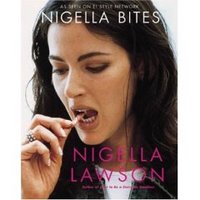 The recipe itself is based on the best recipe for risotto I’ve encountered, Nigella Lawson’s Lemon Risotto (Nigella Bites), which is in turn based on Anna del Conte’s recipe in Secrets of an Italian Kitchen. Food is like fashion in this regard: no need to reinvent the wheel when you can just pull something out of the archives and put a new spin on it. The mushroom fricassée evolved from a hodgepodge of recipes from Julia Child and The Joy of Cooking.
The recipe itself is based on the best recipe for risotto I’ve encountered, Nigella Lawson’s Lemon Risotto (Nigella Bites), which is in turn based on Anna del Conte’s recipe in Secrets of an Italian Kitchen. Food is like fashion in this regard: no need to reinvent the wheel when you can just pull something out of the archives and put a new spin on it. The mushroom fricassée evolved from a hodgepodge of recipes from Julia Child and The Joy of Cooking.
Et voilà:
Risotto with Mushroom Fricassée From Café Gray
Time: 2 hours 45 minutes. Active time: 45 minutes.
For the Fricassée:
1/2 cup dried mushrooms – a mix of chanterelles, morels, hen o woods, oyster
1 cup hot chicken broth, preferably organic
1 cup fresh mushrooms – hen o woods, oyster, fried chicken mushrooms, or whatever is flavorful, available and preferably French
2 tbsp flour
1/2 tsp salt
pinch white pepper
4 tbsp butter
1 tbsp olive oil
1/2 cup water
1/2 cup white wine – a dry Riesling or a floral Sauvignon Blanc
1/2 onion
1 bay leaf
2 sprigs fresh thyme
1 sprig parsley
dash of cognac
Pour the hot broth over the dried mushrooms and soak for at least two hours. You can soak them all day and finish the recipe in the evening if this is more convenient. Scoop out the mushrooms and carefully decant the soaking liquid into a saucepan, leaving the gritty residue of the mushrooms behind. Pick over the reconstituted mushrooms; separate out the tough bits and stems and discard. Prepare the fresh mushrooms: separate them into individual pieces, cutting stems as necessary.
Make a bouquet garni of the onion, bay leaf, thyme, and parsley. Add the water and wine to the mushroom liquid, pop in the bouquet garni, and bring to a boil. Cover and simmer over low heat.
Mix the flour, salt and pepper together in a small bowl. Heat 2 tbsp of the butter and the oil in a saucepan. Saute all the mushrooms, the reconstituted dried ones and the fresh ones, over medium-high heat for a minute. Sprinkle the flour mixture over all, saute for a minute more until the flour melds with the butter and oil, then pour in the mushroom broth, transferring the bouquet garni as you go. Bring it to a boil, then simmer on the lowest temperature, covered, for 10 minutes. The mushrooms should be crunchy, so don’t overcook them. As with any fricassée, you can turn off the heat and reheat the sauce without any negative consequences.
For the risotto:
2 shallots
1 rib celery
1 tbsp olive oil
4 tbsp butter
2/3 cup arborio rice
1 quart chicken stock, preferably organic
1/4 cup grated Parmesan
1 egg yolk
2 tbsp white wine
1/4 cup half & half
salt and white pepper to taste
2 tbsp finely chopped tarragon
Bring the chicken broth to a boil, then cover and reduce to a low simmer.
Chop the shallot and celery to a pulp in a food processor. Heat 2 tbsp of the butter and the olive oil and saute the shallot mixture over medium-low heat for a few minutes, until softened. Add the rice and stir until thoroughly coated with the oil, about 1 minute. Add a ladleful of the broth and stir once. Wait until the rice settles to the bottom and the broth bubbles on top before you stir again. Stir several times and let it settle. Repeat until almost all the broth has been absorbed, then add another ladleful. Don’t forget to salt the risotto to taste as you go.
It’s a myth that you have to stir risotto “constantly.” You can’t really leave the room while you’re making it, but you don’t want to bother it too much, either. Stirring releases the glutens on the rice’s surface and makes the mixture stickier. With the Café Gray risotto, you are aiming for a suspension of rice in thick liquid, not a gummy mass of rice. Don’t overagitate it.
The stove is at the right medium-low temperature when it takes about a minute for a new ladleful of broth to start bubbling quickly at the surface.
When the rice is almost done: If, as you reach the end, you start running out of broth, dilute the remaining broth with hot water and forge ahead.
Whisk the Parmesan, egg yolk, half & half, and white wine together in a small bowl.
Finish the fricassée: Reheat the mushroom mixture and stir in the remaining 2 tbsp butter and a dash of cognac. Salt and pepper to taste.
When the rice is just al dente, the risotto is done. There should be about half a ladleful of liquid remaining with the rice, so that it is the consistency of porridge. Turn off the heat, then stir in the eggy mixture and the remaining 2 tbsp of butter. Salt and pepper to taste. Stir in the chopped tarragon.
Serve absolutely immediately. Pour the risotto into a bowl and the mushroom fricassée into a miniature silver tureen with a jaunty man on top, if you have it. If not, a ceramic dish will do.
Serves 2.







